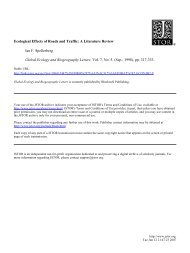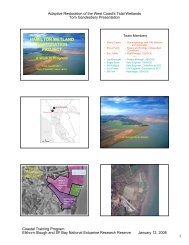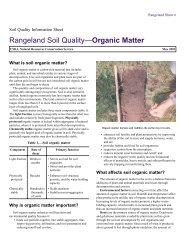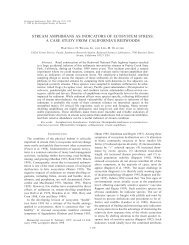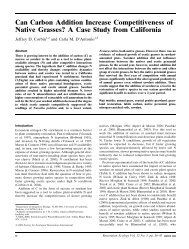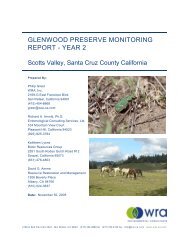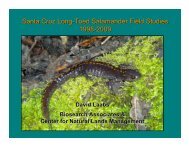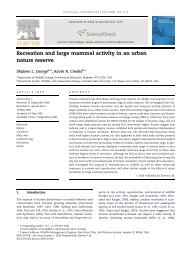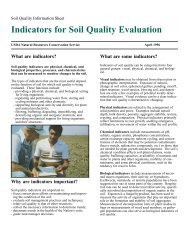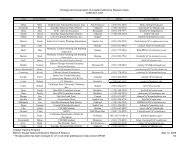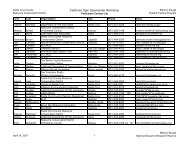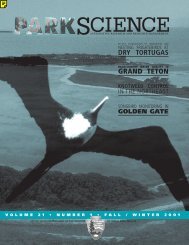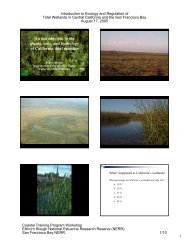BREEDING <strong>BIRD</strong> CENSUS: 200717. PITCH PINE–SLABROCKAREA DE PINO RESINALYNN BOWDERY, TOM SARRO, LIN FAGAN, ALLANBOWDERY & JOE CHERNEKDaniel Smiley Research CenterMohonk Lake1000 Mountain Rest RoadNew Paltz NY 12561Site Number: NY1392063. Location: New York; UlsterCo.; Gardiner; The Near Trapps; 41°44'0"N,74°12'30"W; Gardiner Quadrangle, USGS. Continuity:Established 1992; 4 yr. Size: 15.8 ha. Description ofPlot: See J. Field Ornithol. 64 (Suppl.):86–87 (1993) andBird Populations 7:124 (2006). At the southern end ofthe plot, the hardwood overstory has grown older,and more red maples are getting tall. There are alsosome white pines attaining considerable size, possiblyas a result of fire suppression and the impact of gypsymoth larvae on chestnut oaks. Weather: Mean starttemp., 14.0°C (range 5–29°C). The averagetemperature for May was 2.3°C above the 111-yearaverage, and the precipitation was 1.8 cm (the driestMay on record). The average temperature for Junewas 2.1°C above the 111-year average (the sixthwarmest June on record), and the precipitation was7.6 cm (25% below average). Source: Mohonk LakeCooperative Weather Station. Coverage: 30.6 h; 13visits (12 sunrise, 1 sunset); 15, 22, 25, 28, 31 May; 5, 7,11, 14, 18, 22, 26, 29 June; 2007. Maximum number ofobservers/visit, 8. Census: Chipping Sparrow, 12.0(30); Prairie Warbler, 8.5 (22; 1FL); Black-and-whiteWarbler, 6.0 (15); Eastern Towhee, 4.5 (11); IndigoBunting, 3.5 (9); Black-capped Chickadee, 3.0 (8); PineWarbler, 3.0; Mourning Dove, 2.0; Red-eyed Vireo, 2.0;American Robin, 1.5; Great Crested Flycatcher, 1.0;Tufted Titmouse, 1.0; Cedar Waxwing, 1.0; CommonYellowthroat, 1.0; Dark-eyed Junco, 1.0; ScarletTanager, 1.0; Eastern Phoebe, 0.5; Blue Jay, 0.5; WormeatingWarbler, 0.5; Yellow-billed Cuckoo, +; BlackbilledCuckoo, +; Barred Owl, +; Ruby-throatedHummingbird, +; Downy Woodpecker, +; HairyWoodpecker, + (1FL); Northern Flicker, +; BlueheadedVireo, +; Hermit Thrush, +; Wood Thrush, +;Yellow-rumped Warbler, +; Ovenbird, +; HoodedWarbler, +; Northern Cardinal, +; Baltimore Oriole, +;Purple Finch, +; American Goldfinch, +. Total: 36species; 53.5 territories (135/40 ha). Visitors: SharpshinnedHawk, American Crow, Red-breastedNuthatch, Winter Wren, Magnolia Warbler, BlackthroatedGreen Warbler. Remarks: Compared to the2002 census of this plot, we have been more liberal ingiving infrequently sighted species “+” designationsrather than listing them as visitors. Other Observers:John Thompson, Flo LaValle, Charlotte Gabrielsen,and Shanan Smiley. Acknowledgments: Thanks to theMohonk Preserve for its cooperation.18. FIELD, RIDGE, SHRUBBY TREES, ANDWOODSCAMPOS, COLINAS, ARBUSTOS Y BOSQUESMICHAEL F. G. CLARK101 Governor's Road, #708Dundas ON L9H 6L7Location: Ontario; Municipality of Hamilton-Wentworth; Dundas; Dundas Valley Plot #1; 43°15'N,79°54'W. Continuity: Established 1994; 12 yr. Size: 5.8ha. Description of Plot: See J. Field Ornithol.60(Suppl.):14 (1989), 66(Suppl.):27–28 (1995), and67(Suppl.):73–74 (1996). Weather: Mean start temp.,19.9°C (range 14–24°C). Precipitation was 12.8 cmbelow the norm over the study period. This marks theleast rainfall for the last ten years for which there arerecords. Temperatures from May through July were atthe 30-year norm. Source: Environment Canada.Coverage: 13.1 h; 8 visits (0 sunrise, 3 sunset); 2, 15May; 9, 12, 30 June; 1, 7, 12 July; 2007. Census: YellowWarbler, 27.0 (186); Gray Catbird, 22.0 (152); SongSparrow, 8.0 (55; 1FL); Northern Cardinal, 8.0; FieldSparrow, 6.0 (41); American Goldfinch, 5.0 (34); BluewingedWarbler, 4.0 (28); Indigo Bunting, 4.0;American Robin, 3.0 (21); Rose-breasted Grosbeak,3.0; Great Crested Flycatcher, 2.0 (2FL); Blue Jay, 1.0;Black-capped Chickadee, 1.0; House Wren, 1.0. Total:14 species; 95.0 territories (655/40 ha). Visitors:Cooper’s Hawk, Mourning Dove, Yellow-billedCuckoo, Downy Woodpecker, Northern Flicker, RedeyedVireo, White-breasted Nuthatch, Wood Thrush,Common Yellowthroat, Scarlet Tanager, CommonGrackle, Brown-headed Cowbird. Remarks: Fewerinsects, resulting from this year’s excessive dryness,may have been responsible for the second lowestterritorial males total recorded over 12 years on thisrevised plot. While the typically low numbers ofbreeding thrushes, mimids, and flycatchers were at ornear their 12-year means, the two warbler specieswere 30% below the mean, there were no icterids, andthe three top species (Yellow Warbler, Gray Catbird,and Song Sparrow) were 24% under average.Seedeaters (six species), at just 8% below the mean,likely took advantage of the rich herbal variety inopen areas. The increased bushiness of hawthorns,dogwoods, etc., and increasing canopy in some areasmay be contributing to the ongoing decline ofbreeding numbers for some species. The 14 breedingspecies were four species below the mean.[122]
BREEDING <strong>BIRD</strong> CENSUS: 200719. SHRUBBY SWAMP AND SEDGE HUMMOCKSPANTANO ARBUSTIVO–MOGOTEDAVID ROSGENWhite Memorial Conservation CenterP.O. Box 368Litchfield CT 06759Location: Connecticut; Litchfield Co.; Litchfield; WhiteMemorial Foundation–North Shore Marsh; 41°43'N,73°13'W; Litchfield Quadrangle, USGS. Continuity:Established 1965; 41 yr. Size: 8.1 ha. Description ofPlot: See Aud. Field Notes 19:625–627 (1965) and BirdPopulations 7:125–126 (2006). Three severe floodingevents in the past year altered the vegetation in thiswetland by killing or otherwise damaging some of thetrees and reducing the amount of the herbaceous layer.The shrub cover, which continues to increase insurface area and density, was unaffected by theflooding. Weather: Mean start temp., 24.5°C (range18–29°C). Overall, the weather during May, June, andJuly was pretty nice in northwest Connecticut. It wasvery conducive to vegetation growth, and it helpedproduce an abundance of seeds, nuts, berries, andinsects as the season progressed. Rainfall was belowaverage in May, with 11 wet days producing a total ofonly 4.4 cm of rain. The number of wet days remainedthe same in June, but 8.6 cm of rain fell. That’s a littlebelow average. In July, there were 12 wet days thatproduced a total of 15.5 cm of rain. That’s a little aboveaverage. May’s mean temperature was 14.7°C, whichis a little below average. The mean temperature inJune was 18.6°C, which is close to average. In July, themean temperature was 20.4°C, which is a little belowaverage. Source: White Memorial Foundation’s ownweather station. Coverage: 30.0 h; 12 visits (0 sunrise,9 sunset); 3, 10, 22 May; 2, 9, 16, 28 June; 6, 12, 20, 26,31 July; 2007. Maximum number of observers/ visit, 5.Census: Swamp Sparrow, 34.0 (168; 3N,61FL); RedwingedBlackbird, 31.0 (153; 3N,55FL); Yellow Warbler,26.5 (131; 6N,54FL); Gray Catbird, 21.0 (104; 5N,45FL);Common Yellowthroat, 20.5 (101; 1N,27FL); SongSparrow, 8.5 (42; 2N,17FL); American Goldfinch, 7.5(37; 1N,9FL); Common Grackle, 6.5 (32; 2N,20FL);Veery, 6.0 (30; 12FL); Tree Swallow, 5.5 (27; 5N,28FL);Eastern Kingbird, 4.0 (20; 3N,10FL); Cedar Waxwing,4.0 (1N,9FL); Warbling Vireo, 3.5 (17; 1N,6FL); BlackcappedChickadee, 3.5 (2N,18FL); Tufted Titmouse, 3.5(16FL); American Robin, 3.5 (2N,15FL); BaltimoreOriole, 3.0 (15; 1N,7FL); Blue-gray Gnatcatcher, 2.5(2N,6FL); Northern Cardinal, 2.5 (8FL); WillowFlycatcher, 2.0 (2FL); Least Flycatcher, 2.0 (1N,5FL);Downy Woodpecker, 1.5 (1N,6FL); Eastern Wood-Pewee, 1.5 (2FL); Northern Waterthrush, 1.5 (2FL);Mourning Dove, 1.0 (1FL); Northern Flicker, 1.0 (2FL);Great Crested Flycatcher, 1.0; Yellow-throated Vireo,1.0; Red-eyed Vireo, 1.0; White-breasted Nuthatch, 1.0(6FL); Black-and-white Warbler, 1.0 (3FL); AmericanRedstart, 1.0 (3FL); Canada Goose, 0.5 (4FL); WoodDuck, 0.5 (4FL); Great Blue Heron, 0.5; SpottedSandpiper, 0.5 (2FL); Red-bellied Woodpecker, 0.5;Hairy Woodpecker, 0.5 (3FL); Alder Flycatcher, 0.5;Chestnut-sided Warbler, 0.5; Rose-breasted Grosbeak,0.5; Brown-headed Cowbird, 0.5 (1FL); Yellow-belliedSapsucker, +; Ovenbird, +; Purple Finch, +. Total: 45species; 218.5 territories (1079/40 ha). Visitors:Mallard, Osprey, American Woodcock, Ruby-throatedHummingbird, House Wren, Scarlet Tanager.Remarks: Despite a few cold nights in May, most ofthis year’s breeding season was characterized bynearly ideal weather conditions. Consequently, mostbirds did very well in fledging young (a total of 469 inthis plot). The number of species recorded this yeardecreased to 45 (from 52 last year). This may havebeen due to habitat damaged by earlier floods. Theprevious 10-year average was 43 species. The onlyspecies found this year but not last year were WoodDuck and Ovenbird. The number of territories foundhere this year increased to 218.5. That’s the secondhighest total ever, and it is well above the 10-yearaverage of 189.5. It is 14.5 territories more than weretallied here last year. Swamp Sparrow was the mostabundant species here this year, with Red-wingedBlackbird in second place. Other Observers: LorraineAmalavage, John Eykelhoff, Mary Gendron, LukasHyder, Daren Jacklin, Caitlin MacGinitie, Bill O’Day,John Shugrue, Bob Stanowski, and Terry Weaver.20. COASTAL SCRUBMATORRAL COSTANEROJONATHAN GUNTHER & SCOTT JENNINGSPRBO Conservation Science3820 Cypress Drive #11Petaluma CA 94954Location: California; Marin Co.; Bolinas; PalomarinField Station; 37°55'N, 122°45'W; Bolinas Quadrangle,USGS. Continuity: Established 1971; 33 yr. Size: 8.1ha. Description of Plot: See Am. Birds 25:1003–1004(1971). Succession from coastal scrub to Douglas-fir(Pseudotsuga menziesii) forest continues on the plot.This process occurs relatively uniformly across theentire plot. Weather: Mean start temp., 13.0°C (range8–23°C). The bioyear rainfall total (1 July 2006–30 June2007) was 595.7 mm. The 1976–2007 mean bioyearrainfall was 869.2 mm. The breeding season rainfall (1April–31 July) was 79.5 mm. Coverage: 168.9 h; 57visits (12 sunrise, 0 sunset). 2007. Census: Wrentit, 9.5(47; 9N,28FL); Bewick's Wren, 6.0 (30); Wilson'sWarbler, 4.5 (22); Spotted Towhee, 3.5 (17; 4N,7FL);Orange-crowned Warbler, 3.0 (15); Anna’sHummingbird, 2.5; Swainson's Thrush, 2.5; Bushtit,2.0; Purple Finch, 1.5; Hutton’s Vireo, 1.0; ChestnutbackedChickadee, 1.0; White-crowned Sparrow, 1.0(1N,4FL); Steller's Jay, 0.5; American Robin, 0.5; DarkeyedJunco, 0.5; Red-tailed Hawk, +; Northern Flicker,[123]
- Page 1 and 2:
BIRD POPULATIONSA journal of global
- Page 3 and 4:
BIRD POPULATIONSA journal of global
- Page 6 and 7:
ROBERT L. WILKERSON AND RODNEY B. S
- Page 8 and 9:
ROBERT L. WILKERSON AND RODNEY B. S
- Page 10 and 11:
ROBERT L. WILKERSON AND RODNEY B. S
- Page 12 and 13:
ROBERT L. WILKERSON AND RODNEY B. S
- Page 14 and 15:
ROBERT L. WILKERSON AND RODNEY B. S
- Page 16 and 17:
ROBERT L. WILKERSON AND RODNEY B. S
- Page 18 and 19:
ROBERT L. WILKERSON AND RODNEY B. S
- Page 20 and 21:
ROBERT L. WILKERSON AND RODNEY B. S
- Page 22 and 23:
ROBERT L. WILKERSON AND RODNEY B. S
- Page 24 and 25:
ROBERT L. WILKERSON AND RODNEY B. S
- Page 26 and 27:
ROBERT L. WILKERSON AND RODNEY B. S
- Page 28 and 29:
ROBERT L. WILKERSON AND RODNEY B. S
- Page 30 and 31:
ROBERT L. WILKERSON AND RODNEY B. S
- Page 32 and 33:
ROBERT L. WILKERSON AND RODNEY B. S
- Page 34 and 35:
ROBERT L. WILKERSON AND RODNEY B. S
- Page 36 and 37:
ROBERT L. WILKERSON AND RODNEY B. S
- Page 38 and 39:
ROBERT L. WILKERSON AND RODNEY B. S
- Page 40 and 41:
NIRANJAN DAS AND SUJATA DEORIincluy
- Page 42 and 43:
NIRANJAN DAS AND SUJATA DEORIprovid
- Page 44 and 45:
NIRANJAN DAS AND SUJATA DEORIpopula
- Page 46 and 47:
NIRANJAN DAS AND SUJATA DEORITABLE
- Page 48 and 49:
NIRANJAN DAS AND SUJATA DEORITABLE
- Page 50 and 51:
NIRANJAN DAS AND SUJATA DEORITABLE
- Page 52 and 53:
NIRANJAN DAS AND SUJATA DEORITABLE
- Page 54 and 55:
NIRANJAN DAS AND SUJATA DEORITABLE
- Page 56 and 57:
NIRANJAN DAS AND SUJATA DEORITABLE
- Page 58 and 59:
Bird Populations 10:56-64© The Ins
- Page 60 and 61:
WETLAND BIRDS OF GHANAAvicennia afr
- Page 62 and 63:
WETLAND BIRDS OF GHANATABLE 1. Data
- Page 64 and 65:
WETLAND BIRDS OF GHANATABLE 2: Esti
- Page 66 and 67:
WETLAND BIRDS OF GHANAATTUQUAYEFIO,
- Page 68 and 69:
JANNIK HANSEN, LARS HOLST HANSEN, N
- Page 70 and 71:
JANNIK HANSEN, LARS HOLST HANSEN, N
- Page 72 and 73:
JANNIK HANSEN, LARS HOLST HANSEN, N
- Page 74 and 75: JANNIK HANSEN, LARS HOLST HANSEN, N
- Page 76 and 77: JANNIK HANSEN, LARS HOLST HANSEN, N
- Page 78 and 79: JANNIK HANSEN, LARS HOLST HANSEN, N
- Page 80 and 81: JANNIK HANSEN, LARS HOLST HANSEN, N
- Page 82 and 83: JANNIK HANSEN, LARS HOLST HANSEN, N
- Page 84 and 85: JANNIK HANSEN, LARS HOLST HANSEN, N
- Page 86 and 87: JANNIK HANSEN, LARS HOLST HANSEN, N
- Page 88 and 89: JANNIK HANSEN, LARS HOLST HANSEN, N
- Page 90 and 91: BIRD POPULATIONSA journal of global
- Page 92 and 93: Bird Populations 10:90-109© The In
- Page 94 and 95: DAVID J. ZIOLKOWSKI JR., KEITH L. P
- Page 96 and 97: DAVID J. ZIOLKOWSKI JR., KEITH L. P
- Page 98 and 99: DAVID J. ZIOLKOWSKI JR., KEITH L. P
- Page 100 and 101: DAVID J. ZIOLKOWSKI JR., KEITH L. P
- Page 102 and 103: DAVID J. ZIOLKOWSKI JR., KEITH L. P
- Page 104 and 105: DAVID J. ZIOLKOWSKI JR., KEITH L. P
- Page 106 and 107: DAVID J. ZIOLKOWSKI JR., KEITH L. P
- Page 108 and 109: DAVID J. ZIOLKOWSKI JR., KEITH L. P
- Page 110 and 111: DAVID J. ZIOLKOWSKI JR., KEITH L. P
- Page 112 and 113: Bird Populations 10:110-113© The I
- Page 114 and 115: THE 2007 AND 2008 NORTH AMERICAN BR
- Page 116 and 117: Bird Populations 10:114-124© The I
- Page 118 and 119: BREEDING BIRD CENSUS: 2007on the pl
- Page 120 and 121: BREEDING BIRD CENSUS: 2007May, with
- Page 122 and 123: BREEDING BIRD CENSUS: 2007Remarks:
- Page 126 and 127: BREEDING BIRD CENSUS: 2007+; Wester
- Page 128 and 129: BREEDING BIRD CENSUS: 2008gray Gnat
- Page 130 and 131: BREEDING BIRD CENSUS: 2008Warbler,
- Page 132 and 133: BREEDING BIRD CENSUS: 2008Source: W
- Page 134 and 135: BREEDING BIRD CENSUS: 2008Spotted T
- Page 136 and 137: BREEDING BIRD CENSUS: 2008precipita
- Page 138 and 139: Bird Populations 10© The Institute
- Page 140 and 141: IS AVIAN BREEDING SUCCESS WEATHERIN
- Page 142 and 143: IS AVIAN BREEDING SUCCESS WEATHERIN
- Page 144 and 145: DAVE LEECH AND CARL BARIMOREFlycatc
- Page 146 and 147: Bird Populations 10:143-145Reprinte
- Page 148 and 149: WOODPIGEON JOINS THE GARDEN PREMIER
- Page 150 and 151: CHANGING THE GUARD AT UK BIRDTABLES
- Page 152 and 153: Bird Populations is an entirely ele
- Page 154: BIRD POPULATIONSA journal of global



